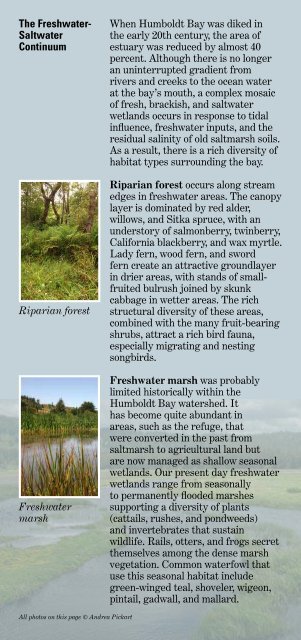Humboldt Bay - U.S. Fish and Wildlife Service
Humboldt Bay - U.S. Fish and Wildlife Service
Humboldt Bay - U.S. Fish and Wildlife Service
You also want an ePaper? Increase the reach of your titles
YUMPU automatically turns print PDFs into web optimized ePapers that Google loves.
The Freshwater-<br />
Saltwater<br />
Continuum<br />
Riparian forest<br />
Freshwater<br />
marsh<br />
All photos on this page © Andrea Pickart<br />
When <strong>Humboldt</strong> <strong>Bay</strong> was diked in<br />
the early 20th century, the area of<br />
estuary was reduced by almost 40<br />
percent. Although there is no longer<br />
an uninterrupted gradient from<br />
rivers <strong>and</strong> creeks to the ocean water<br />
at the bay’s mouth, a complex mosaic<br />
of fresh, brackish, <strong>and</strong> saltwater<br />
wetl<strong>and</strong>s occurs in response to tidal<br />
infuence, freshwater inputs, <strong>and</strong> the<br />
residual salinity of old saltmarsh soils.<br />
As a result, there is a rich diversity of<br />
habitat types surrounding the bay.<br />
Riparian forest occurs along stream<br />
edges in freshwater areas. The canopy<br />
layer is dominated by red alder,<br />
willows, <strong>and</strong> Sitka spruce, with an<br />
understory of salmonberry, twinberry,<br />
California blackberry, <strong>and</strong> wax myrtle.<br />
Lady fern, wood fern, <strong>and</strong> sword<br />
fern create an attractive groundlayer<br />
in drier areas, with st<strong>and</strong>s of smallfruited<br />
bulrush joined by skunk<br />
cabbage in wetter areas. The rich<br />
structural diversity of these areas,<br />
combined with the many fruit-bearing<br />
shrubs, attract a rich bird fauna,<br />
especially migrating <strong>and</strong> nesting<br />
songbirds.<br />
Freshwater marsh was probably<br />
limited historically within the<br />
<strong>Humboldt</strong> <strong>Bay</strong> watershed. It<br />
has become quite abundant in<br />
areas, such as the refuge, that<br />
were converted in the past from<br />
saltmarsh to agricultural l<strong>and</strong> but<br />
are now managed as shallow seasonal<br />
wetl<strong>and</strong>s. Our present day freshwater<br />
wetl<strong>and</strong>s range from seasonally<br />
to permanently fooded marshes<br />
supporting a diversity of plants<br />
(cattails, rushes, <strong>and</strong> pondweeds)<br />
<strong>and</strong> invertebrates that sustain<br />
wildlife. Rails, otters, <strong>and</strong> frogs secret<br />
themselves among the dense marsh<br />
vegetation. Common waterfowl that<br />
use this seasonal habitat include<br />
green-winged teal, shoveler, wigeon,<br />
pintail, gadwall, <strong>and</strong> mallard.<br />
Agricultural<br />
wetl<strong>and</strong>s<br />
Brackish marsh<br />
Saltmarsh<br />
Mudfats<br />
Agricultural wetl<strong>and</strong>s are diked<br />
former saltmarshes that support<br />
pasture grasses such as ryegrass,<br />
velvet grass, <strong>and</strong> tall fescue, as well<br />
as the native wetl<strong>and</strong> species shortawned<br />
foxtail <strong>and</strong> Pacifc silverweed.<br />
These areas are hayed or grazed to<br />
maintain the shortgrass pastures<br />
attractive to Aleutian cackling geese.<br />
They are also used by shorebirds,<br />
herons, egrets, <strong>and</strong> black-tailed deer.<br />
Brackish marsh occurs where<br />
salt <strong>and</strong> fresh water mix or where<br />
salts in the soil remain high. These<br />
wetl<strong>and</strong>s support native saltgrass,<br />
tufted hairgrass, <strong>and</strong> two species of<br />
arrowgrass. The edges of former<br />
tidal channels, where water levels are<br />
more constant, are lined with seacoast<br />
bulrush. These sloughs are used by<br />
salmonids <strong>and</strong> tidewater gobies, all<br />
listed species.<br />
Saltmarsh was the most widespread<br />
wetl<strong>and</strong> type around <strong>Humboldt</strong><br />
<strong>Bay</strong>, but due to diking <strong>and</strong> draining<br />
in the early 1900s only 10 percent<br />
of our saltmarshes remain. Of the<br />
remaining 900 acres, most have been<br />
invaded by the aggressive densefowered<br />
cordgrass, introduced in the<br />
19th century in the ballast of ships.<br />
Cordgrass is currently being removed<br />
to restore a diverse community of<br />
plants including pickleweed, jaumea,<br />
saltgrass, <strong>and</strong> several rare species.<br />
Intertidal mudfat <strong>and</strong> eelgrass<br />
beds occupy vast areas of the bay.<br />
Seemingly barren mudfats teem with<br />
life just beneath the surface. Plankton<br />
<strong>and</strong> algae anchor food webs of<br />
invertebrates, mollusks, crustaceans,<br />
fsh, birds, <strong>and</strong> mammals, including<br />
humans. The intertidal fats of South<br />
<strong>Bay</strong> support approximately 2,000<br />
acres of eelgrass, which are critically<br />
important to Pacifc brant, other<br />
waterbirds, <strong>and</strong> the bay ecosystem.

















